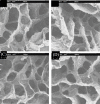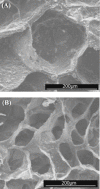Effect of Dioxane and N-Methyl-2-pyrrolidone as a Solvent on Biocompatibility and Degradation Performance of PLGA/nHA Scaffolds
- PMID: 34641642
- PMCID: PMC8744699
- DOI: 10.52547/ibj.25.6.408
Effect of Dioxane and N-Methyl-2-pyrrolidone as a Solvent on Biocompatibility and Degradation Performance of PLGA/nHA Scaffolds
Abstract
Background: Solvent casting/particulate leaching is one of the most conventional methods for fabricating polymer/ceramic composite scaffolds. In this method, the solvent generally affects resulting scaffold properties, including porosity and degradation rate.
Methods: Herein, composite scaffolds of PLGA (poly(lactide-co-glycolide))/ nano-hydroxyapatite (nHA) with different percentages of nHA (25, 35, and 45 wt. %) were prepared by the solvent casting/particle leaching combined with freeze drying. The effects of two different solvents, 1,4-dioxane (DIO) and N-methyl-2-pyrrolidone (NMP), on morphology, porosity, bioactivity, degradation rate, and biocompatibility of the resulting scaffolds were investigated.
Results: The results revealed that increasing the nano-hydroxyapatite (nHA) percentages had no significant effect on the porosity and interconectivity of scaffolds (p > 0.05), whereas altering the solvent from DIO into NMP decreased the porosity from about 87% into 71%, respectively. Moreover, scaffolds of DIO illustrated the high results of cell proliferation compared to those of NMP; the cell viability of GD25 decreased from 85% to 65% for GN25. The findings also indicated that scaffolds prepared by NMP had a higher rate of losing weight in comparison to DIO. Adding nHA to PLGA had a significant effect on the bioactivity of scaffolds (p < 0.05), composite scaffolds with 45 wt % nHA had at least 30% more weight gain compared to the neat polymer scaffolds.
Conclusion: The DIO scaffolds have higher rates of porosity, interconnectivity, bioactivity, and biocompatibility than NMP scaffolds due to its high evaporation rate.
Keywords: Freeze drying; Porosity; Solvents.
Figures








References
-
- Gu Z, Kong L, Feng X, Guo T, Dai J, Li S, Huo N, Ding Y. Synthesis and characterization of PLGA–gelatin complex with growth factor incorporation as potential matrix. Journal of alloys and compounds. 2009;474(1-2):450–454.
-
- Christy PN, Basha SK, Kumari VS, Bashir A, Maaza M, Kaviyarasu K, Arasu MV, Al-Dhabi NA, Ignacimuthu S. Biopolymeric nanocomposite scaffolds for bone tissue engineering applications–A review. Journal of drug delivery science and technology. 2020;55
-
- Tsang VL, Bhatia SN. Three-dimensional tissue fabrication. Advanced drug delivery reviews. 2004;56(11):1635–1647. - PubMed
-
- Cai M, Liu H, Jiang Y, Wang J, Zhang S. A high-strength biodegradable thermoset polymer for internal fixation bone screws: Preparation, in vitro and in vivo evaluation. Colloids and surfaces B: siointerfaces. 2019;183:110445. - PubMed
-
- Ignatius A, Claes LE. In vitro biocompatibility of bioresorbable polymers: poly (L, DL-lactide) and poly (L-lactide-co-glycolide) Biomaterials. 1996;17(8):831–839. - PubMed
MeSH terms
Substances
LinkOut - more resources
Full Text Sources
